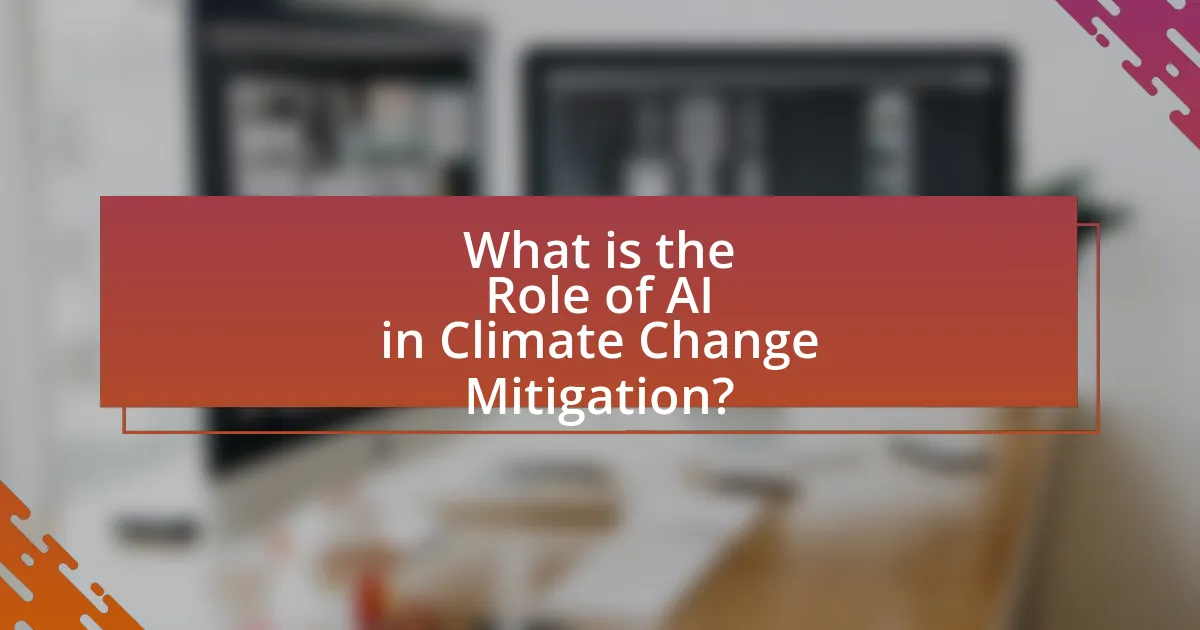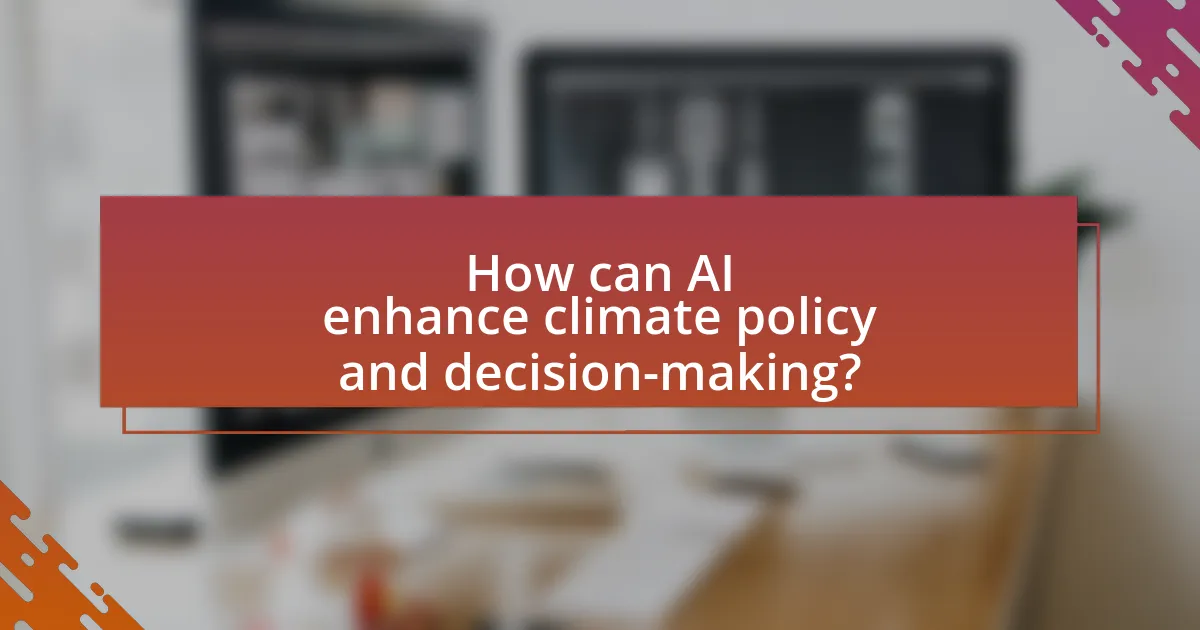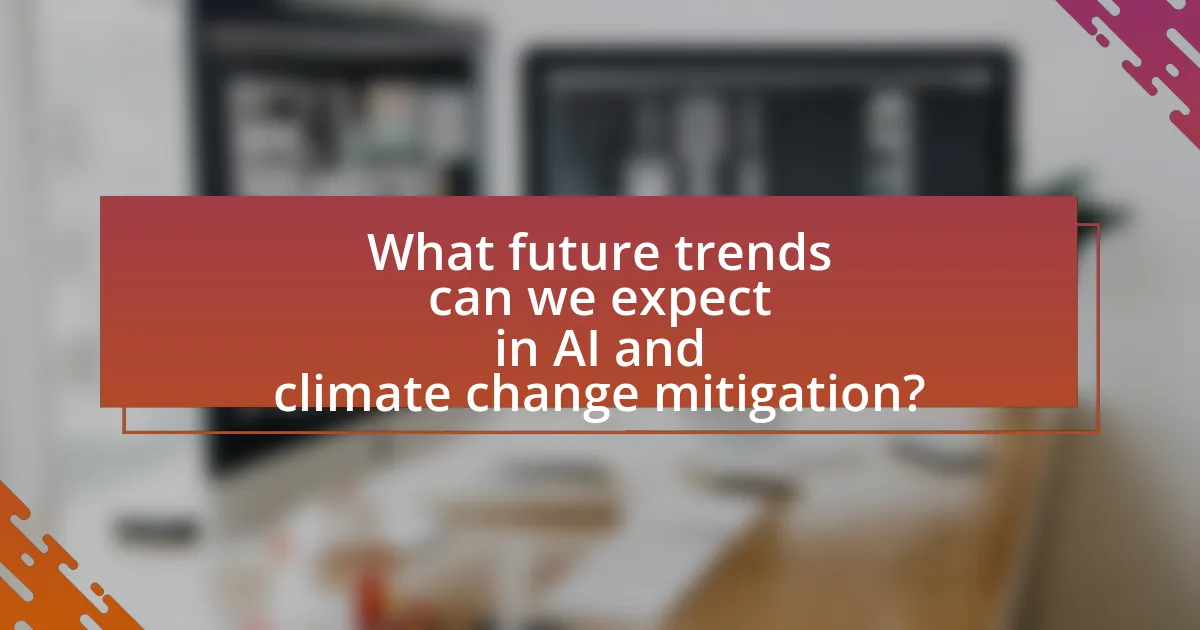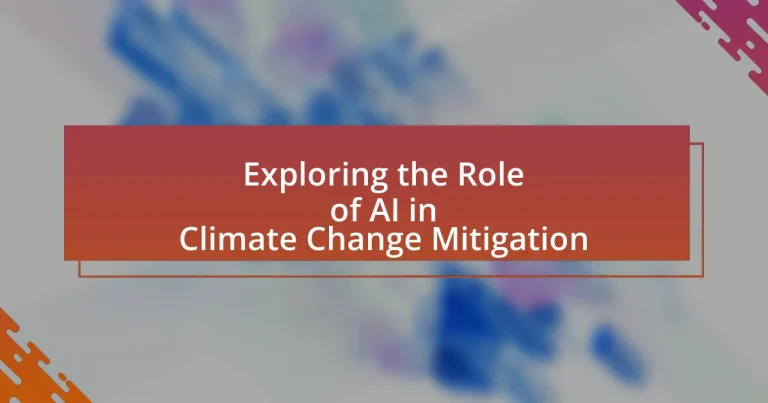The article explores the significant role of artificial intelligence (AI) in climate change mitigation, highlighting its applications in data analysis, resource management, and predictive modeling. AI enhances understanding of climate change by processing vast datasets, improving climate models, and optimizing energy consumption, potentially reducing global CO2 emissions by up to 4 gigatons annually by 2030. Key applications include renewable energy optimization, carbon capture technologies, and scenario analysis for climate strategies. The article also addresses challenges such as data quality, ethical considerations, and the need for transparency in AI deployment, while emphasizing best practices for effective implementation in climate initiatives.

What is the Role of AI in Climate Change Mitigation?
AI plays a crucial role in climate change mitigation by enhancing data analysis, optimizing resource management, and improving predictive modeling. For instance, AI algorithms can analyze vast datasets to identify patterns in climate-related phenomena, enabling more accurate forecasting of climate impacts. Additionally, AI technologies are employed in energy management systems to optimize energy consumption and reduce greenhouse gas emissions. A study by the International Energy Agency indicates that AI could help reduce global CO2 emissions by up to 4 gigatons annually by 2030 through improved efficiency in various sectors. This demonstrates the significant potential of AI in addressing climate change challenges effectively.
How does AI contribute to understanding climate change?
AI contributes to understanding climate change by analyzing vast datasets to identify patterns and predict future climate scenarios. Machine learning algorithms process satellite imagery, climate models, and historical weather data, enabling researchers to gain insights into climate trends and the impact of human activities. For instance, a study published in Nature Climate Change demonstrated that AI can improve climate models’ accuracy by up to 30%, allowing for better predictions of extreme weather events. This enhanced understanding aids policymakers in making informed decisions regarding climate action and mitigation strategies.
What data does AI analyze to assess climate change impacts?
AI analyzes various types of data to assess climate change impacts, including satellite imagery, climate models, historical weather data, greenhouse gas emissions data, and socio-economic indicators. Satellite imagery provides real-time observations of land use changes, deforestation, and ice melt, while climate models simulate future climate scenarios based on different emission pathways. Historical weather data offers insights into past climate trends, and greenhouse gas emissions data quantifies the sources and levels of emissions contributing to climate change. Socio-economic indicators help evaluate the vulnerability and adaptive capacity of communities affected by climate change. These data sources collectively enable AI to identify patterns, predict future impacts, and inform mitigation strategies effectively.
How does AI improve climate modeling and predictions?
AI enhances climate modeling and predictions by processing vast datasets more efficiently than traditional methods. Machine learning algorithms analyze historical climate data, identify patterns, and generate more accurate forecasts. For instance, a study published in Nature Climate Change demonstrated that AI models could predict temperature changes with a 20% higher accuracy compared to conventional models. Additionally, AI can integrate diverse data sources, such as satellite imagery and oceanographic data, enabling a more comprehensive understanding of climate dynamics. This capability allows for improved simulations of climate scenarios, ultimately aiding in better decision-making for climate change mitigation strategies.
What are the key applications of AI in climate change mitigation?
Key applications of AI in climate change mitigation include optimizing energy consumption, enhancing climate modeling, and improving carbon capture technologies. AI algorithms analyze vast datasets to identify patterns and predict energy usage, leading to more efficient energy management in buildings and industries. For instance, AI-driven systems can reduce energy consumption by up to 30% in smart buildings. Additionally, AI enhances climate models by processing complex climate data, allowing for more accurate predictions of climate impacts and informing policy decisions. Furthermore, AI technologies are employed in carbon capture and storage, optimizing the processes to increase efficiency and reduce costs, which is crucial for achieving net-zero emissions targets.
How is AI used in renewable energy optimization?
AI is used in renewable energy optimization by enhancing the efficiency and reliability of energy systems through predictive analytics and real-time data processing. For instance, machine learning algorithms analyze historical weather data to forecast energy production from solar panels and wind turbines, allowing for better grid management and energy distribution. A study by the International Renewable Energy Agency (IRENA) found that AI can improve the efficiency of renewable energy systems by up to 30%, demonstrating its significant impact on optimizing energy resources.
What role does AI play in carbon capture and storage technologies?
AI plays a crucial role in enhancing the efficiency and effectiveness of carbon capture and storage (CCS) technologies. By utilizing machine learning algorithms, AI can optimize the design and operation of carbon capture systems, improving their ability to identify and capture CO2 emissions from various sources. For instance, AI models can analyze vast datasets to predict the performance of different capture materials and processes, leading to more effective selection and deployment. Additionally, AI aids in monitoring and managing the storage of captured carbon, ensuring that it remains securely contained and does not leak into the atmosphere. Research has shown that AI-driven predictive maintenance can reduce operational costs and downtime in CCS facilities, thereby increasing their overall viability as a climate change mitigation strategy.
What challenges does AI face in climate change mitigation?
AI faces several challenges in climate change mitigation, including data quality, scalability, and ethical considerations. The effectiveness of AI models relies heavily on high-quality, comprehensive datasets, which are often lacking in climate science. Additionally, scaling AI solutions to address global climate issues requires significant computational resources and infrastructure, which may not be accessible in all regions. Ethical concerns also arise regarding data privacy and the potential for biased algorithms, which can lead to inequitable outcomes in climate policy. These challenges hinder the full potential of AI in effectively mitigating climate change impacts.
How do data privacy and ethical concerns affect AI deployment?
Data privacy and ethical concerns significantly hinder AI deployment by imposing strict regulations and fostering public distrust. These concerns arise from the potential misuse of personal data, leading to legal frameworks such as the General Data Protection Regulation (GDPR) in Europe, which mandates transparency and consent in data handling. Additionally, ethical dilemmas regarding bias in AI algorithms can result in unfair treatment of certain groups, prompting organizations to reconsider their AI strategies to ensure fairness and accountability. Consequently, these factors can delay project timelines, increase costs, and limit the scope of AI applications in critical areas like climate change mitigation, where trust and compliance are essential for effective implementation.
What are the limitations of AI in addressing climate change?
AI has limitations in addressing climate change, primarily due to data quality, interpretability, and ethical concerns. The effectiveness of AI models relies heavily on the availability of high-quality, comprehensive datasets; however, many regions lack sufficient data on emissions, climate patterns, and ecological impacts, which hampers accurate modeling. Additionally, AI algorithms can be complex and difficult to interpret, making it challenging for stakeholders to understand decision-making processes and trust the outcomes. Ethical concerns also arise, such as potential biases in data that could lead to inequitable solutions or unintended consequences. These limitations highlight the need for improved data collection, transparency in AI processes, and ethical considerations in AI applications for climate change mitigation.

How can AI enhance climate policy and decision-making?
AI can enhance climate policy and decision-making by providing data-driven insights and predictive analytics that inform strategies for climate action. For instance, AI algorithms can analyze vast datasets from climate models, satellite imagery, and socio-economic factors to identify trends and potential impacts of climate change, enabling policymakers to make informed decisions. A study by the World Economic Forum highlights that AI can improve climate modeling accuracy by up to 30%, allowing for better forecasting of climate-related events and more effective resource allocation. Additionally, AI can optimize energy consumption and emissions reduction strategies, as demonstrated by projects that utilize machine learning to enhance energy efficiency in urban planning and transportation systems.
What insights can AI provide for policymakers?
AI can provide policymakers with data-driven insights that enhance decision-making in climate change mitigation. By analyzing vast datasets, AI can identify patterns and predict the impacts of various policies on emissions reduction, resource allocation, and environmental sustainability. For instance, AI models can simulate the effects of renewable energy adoption on carbon footprints, allowing policymakers to evaluate the effectiveness of different strategies before implementation. Research from the International Energy Agency indicates that AI can improve energy efficiency by up to 10% in various sectors, demonstrating its potential to inform effective climate policies.
How does AI facilitate scenario analysis for climate strategies?
AI facilitates scenario analysis for climate strategies by enabling the processing of vast datasets to model potential climate outcomes and assess the effectiveness of various strategies. Through machine learning algorithms, AI can analyze historical climate data, simulate future scenarios, and identify patterns that inform decision-making. For instance, AI-driven models can predict the impact of different emission reduction policies on global temperatures, helping policymakers evaluate the most effective approaches. Research from the World Economic Forum highlights that AI can enhance predictive accuracy by up to 30%, thereby improving the reliability of scenario analyses in climate strategy development.
What role does AI play in stakeholder engagement and communication?
AI enhances stakeholder engagement and communication by providing data-driven insights and facilitating real-time interactions. Through natural language processing and machine learning, AI analyzes stakeholder sentiments and preferences, enabling organizations to tailor their communication strategies effectively. For instance, AI tools can process large volumes of feedback from stakeholders, identifying key concerns and trends that inform decision-making. Research indicates that organizations utilizing AI for stakeholder engagement report improved satisfaction and collaboration, as AI-driven platforms streamline communication and foster transparency.
How can AI support international climate agreements?
AI can support international climate agreements by enhancing data analysis, improving predictive modeling, and facilitating real-time monitoring of emissions. For instance, AI algorithms can analyze vast datasets to identify trends in greenhouse gas emissions, enabling countries to set more accurate targets. Additionally, AI-driven models can predict the impacts of climate policies, helping nations assess the effectiveness of their commitments. A study by the International Energy Agency in 2021 highlighted that AI could reduce global CO2 emissions by up to 4% by optimizing energy use and improving efficiency in various sectors. This demonstrates AI’s potential to play a crucial role in achieving the goals set by international climate agreements.
What tools does AI offer for tracking emissions and compliance?
AI offers various tools for tracking emissions and compliance, including predictive analytics, real-time monitoring systems, and automated reporting software. Predictive analytics utilizes historical data to forecast future emissions, enabling organizations to make informed decisions about their environmental impact. Real-time monitoring systems leverage IoT sensors to collect data on emissions continuously, ensuring compliance with regulations. Automated reporting software streamlines the process of compiling and submitting emissions data to regulatory bodies, reducing human error and increasing efficiency. These tools collectively enhance transparency and accountability in emissions management, supporting organizations in meeting compliance requirements effectively.
How can AI improve transparency in climate action reporting?
AI can improve transparency in climate action reporting by automating data collection and analysis, ensuring accurate and timely reporting of emissions and climate initiatives. For instance, AI algorithms can process vast amounts of environmental data from various sources, such as satellite imagery and IoT sensors, to provide real-time insights into carbon footprints and the effectiveness of climate policies. A study by the World Economic Forum highlights that AI can enhance data accuracy by reducing human error and bias, thereby fostering trust among stakeholders. Additionally, AI-driven platforms can facilitate public access to climate data, allowing for independent verification and accountability in climate action efforts.

What future trends can we expect in AI and climate change mitigation?
Future trends in AI and climate change mitigation include enhanced predictive analytics, improved energy efficiency, and advanced climate modeling. AI technologies are increasingly being utilized to analyze vast datasets, enabling more accurate predictions of climate patterns and the impacts of climate change. For instance, machine learning algorithms can optimize energy consumption in buildings, reducing carbon footprints significantly; studies show that AI can improve energy efficiency by up to 20%. Additionally, AI-driven simulations are being developed to model climate scenarios, allowing policymakers to make informed decisions based on potential future outcomes. These advancements demonstrate AI’s critical role in addressing climate challenges effectively.
How is AI evolving to meet climate challenges?
AI is evolving to meet climate challenges by enhancing predictive analytics, optimizing resource management, and improving climate modeling. For instance, machine learning algorithms analyze vast datasets to forecast weather patterns and climate impacts more accurately, enabling better preparedness for extreme weather events. Additionally, AI-driven systems optimize energy consumption in buildings and industrial processes, significantly reducing carbon footprints. Research from the International Energy Agency indicates that AI applications in energy efficiency could lead to a 10% reduction in global energy demand by 2030. Furthermore, AI is being utilized in agriculture to optimize water usage and crop yields, contributing to sustainable food production amidst changing climate conditions.
What advancements in AI technology are on the horizon?
Advancements in AI technology on the horizon include enhanced machine learning algorithms, improved natural language processing capabilities, and the integration of AI with climate modeling tools. These developments will enable more accurate predictions of climate patterns and facilitate real-time data analysis for climate change mitigation efforts. For instance, researchers are working on AI systems that can analyze vast datasets from satellite imagery to monitor deforestation and carbon emissions more effectively. Additionally, AI-driven optimization techniques are being developed to improve energy efficiency in various sectors, which can significantly reduce greenhouse gas emissions.
How might AI integration with other technologies enhance climate solutions?
AI integration with other technologies can significantly enhance climate solutions by optimizing resource management and improving predictive analytics. For instance, AI algorithms can analyze vast datasets from IoT devices to monitor environmental conditions, leading to more efficient energy consumption and waste management. A study by the International Energy Agency indicates that AI could reduce global greenhouse gas emissions by up to 4% by 2030 through enhanced energy efficiency and renewable energy integration. This demonstrates that the synergy between AI and technologies like IoT and big data analytics can drive substantial progress in climate change mitigation efforts.
What best practices should be followed when implementing AI for climate change?
Best practices for implementing AI for climate change include ensuring data quality, fostering interdisciplinary collaboration, prioritizing transparency, and focusing on scalability. High-quality, relevant data is essential for accurate AI models, as demonstrated by the success of AI in predicting climate patterns when trained on comprehensive datasets. Interdisciplinary collaboration among climate scientists, data scientists, and policymakers enhances the effectiveness of AI applications, as seen in projects like ClimateAI, which integrates diverse expertise. Transparency in AI algorithms and decision-making processes builds trust and facilitates accountability, crucial for public acceptance. Finally, focusing on scalable solutions ensures that AI applications can be adapted and expanded to address various climate challenges effectively, as evidenced by AI-driven initiatives that have successfully scaled from local to global contexts.
How can organizations ensure ethical AI use in climate initiatives?
Organizations can ensure ethical AI use in climate initiatives by implementing clear ethical guidelines and frameworks that prioritize transparency, accountability, and fairness. Establishing these guidelines helps organizations navigate the complexities of AI applications in climate-related projects, ensuring that data usage respects privacy and avoids bias. For instance, the European Commission’s guidelines on trustworthy AI emphasize the importance of human oversight and the need for AI systems to be robust and secure, which can be directly applied to climate initiatives. Additionally, organizations can engage stakeholders, including communities affected by climate change, to gather diverse perspectives and foster inclusive decision-making processes. This approach not only enhances the ethical deployment of AI but also aligns with the principles of sustainable development, as outlined in the United Nations Sustainable Development Goals.
What strategies can maximize the effectiveness of AI in climate action?
To maximize the effectiveness of AI in climate action, implementing data-driven decision-making strategies is essential. These strategies include utilizing AI for predictive analytics to forecast climate patterns, optimizing resource allocation through machine learning algorithms, and enhancing energy efficiency via smart grid technologies. For instance, a study by the International Energy Agency indicates that AI can improve energy efficiency in buildings by up to 30% through real-time data analysis and automation. Additionally, deploying AI in climate modeling can lead to more accurate simulations, enabling better policy-making and resource management. By integrating AI into these areas, stakeholders can significantly enhance their climate action initiatives.




